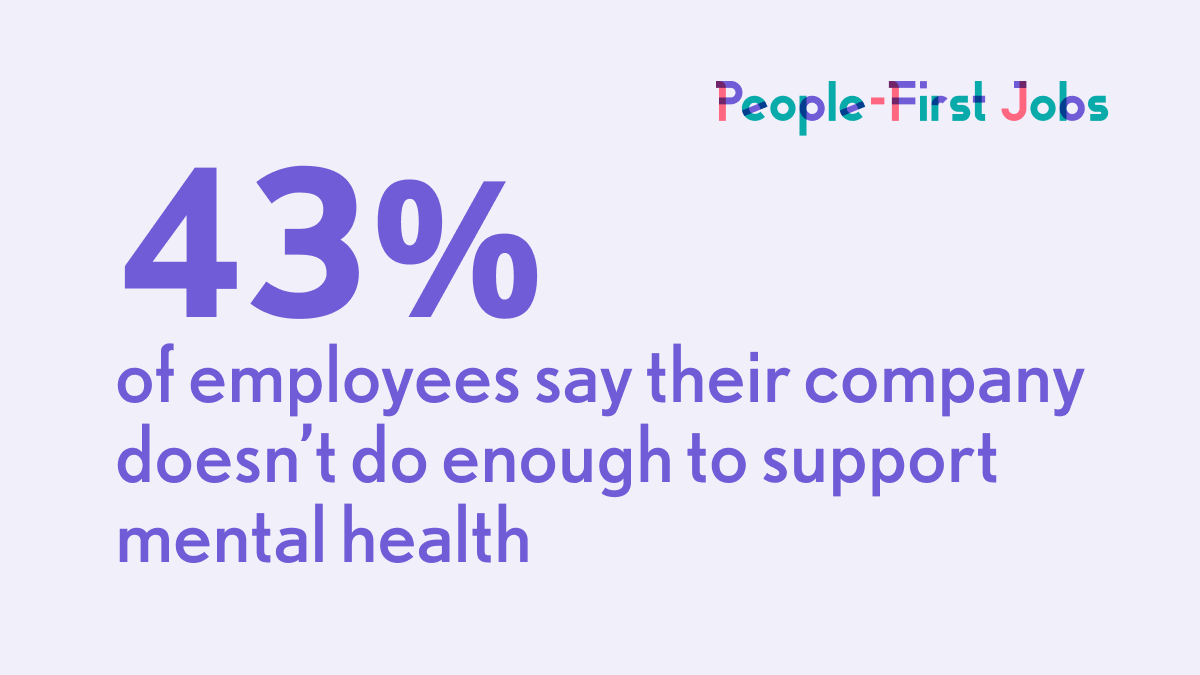The state of mental health at work and what you can do to support your team
Let's look into two recent reports about the state of mental health and burnout at work—and discover how people-first companies are supporting their teams.

The days when companies could ignore employee mental health are long gone. According to the National Institute of Mental Health (NIMH), nearly 1 in 4 US adults live with a mental illness and over 5% have severe conditions that affect their ability to function day-to-day.
Employee burnout, which can cause mental health issues, continues to be a costly problem, leading to higher turnover rates, absenteeism, and reduced productivity. Studies have also found that when searching for new jobs, applicants now consider whether employers will support their mental health a key concern.
Some highlights from recent reports
The COVID-19 pandemic turned employee mental health into a top priority for businesses. Several studies analyze the relationship between mental health and work—we looked at two of them in detail:
Calm 2023 Workplace Mental Health Trends Report: The Future of Work
In late 2022, Calm looked at user patterns of 4 million+ subscribers and surveyed 2,000 individuals to better understand employee mental health needs. Here are some insights that stood out to us:
- Workplace stress is the main reason Calm subscribers use the app (42%).
- 67% think employers should help employees take care of mental health needs, while 33% think it’s up to the individual.
- Younger generations are more vocal: 72% of Gen Zers want to talk about mental health openly at work.
- GenZers and millennials report the most stress and anxiety across all generations.
- Neurodivergent, LGBTQ+, Hispanic, and low-income employees have unique mental health needs and feel disproportionately unsupported.
2023 Kona Remote Burnout Report
The World Health Organization (WHO) considers burnout an occupational phenomenon. It is not classified as a medical condition (contrary to depression, for example). It’s a syndrome “resulting from chronic workplace stress (my emphasis) that has not been successfully managed.”
For their 2023 Remote Burnout Report (make sure to take a look!), the wonderful people at Kona surveyed more than 300 remote leaders and tech workers at top start-ups. Here are some central findings:
- 70% of remote managers experienced burnout in 2023.
- HR, Marketing, and Support are the most burned-out departments in organizations.
- Employees who spent 3-5 years at a company were at the most risk of burnout.
- 65% of remote workers who experience burnout frequently are women.
- Only 57% of remote employees felt their company did enough to support mental health.
Looking at the flip side of this last point: 43% did not feel that their company did enough to support mental health. When competing for new talent and trying to retain the great people in your team, you don’t want to fall into that second group.
How you can support your team’s mental health
We turned to the people-first community for inspiration about what they do to support mental health and reduce the risk of burnout in their teams—here are four areas you can tackle:
Normalize conversations about well-being and mental health
In many organizations, talking about mental health is still stigmatized or taboo. If employees don’t feel psychologically safe enough to share their struggles, managers can’t support them and their needs effectively. That’s why it’s crucial to create an environment in which talking about mental health is as normal as talking about physical health—one free from judgment or fear of exclusion.
"The most important thing I believe we do for mental health at work is normalize the idea that all emotions are valid and that all humans need help sometimes."
— Courtney Seiter, Former Director of People at Buffer
Buffer tries to make space for all different moods and emotions when the team communicates with each other. A few years ago, they introduced an “energy check” or “traffic light” exercise at the beginning of smaller meetings, where they take turns to share what color they’re “feeling”:
- Red (Overwhelmed, upset, having a tough time)
- Yellow (Things are not ideal but hanging in there)
- Green (Feeling good about things)
Colleagues can choose to just name the color or say more about why they chose it. You can also use tools like Kona to do these check-ins—and monitor developments over time.
Don’t try to fix it
When a person in your team talks to you about a mental health issue (well done, they trust you!), your primary role should be that of listener. As managers, we’re no mental health professionals and while we might be great at solving day-to-day work problems, that’s not our job here:
“Approach your colleagues with the mindset that they are resourceful, able, and may need your support but not necessarily solutions. You want to be a bridge to resources, rather than being the resource yourself,” recommends speaker and coach Deborah Grayson Riegel in her recent Harvard Business Review article.
Everybody is different and people often know what they need, so the best you can do in this situation is to ask questions like:
- What would be most helpful for you right now?
- How can I support you?
- How can we as a team/company improve on listening and supporting you moving forward?
And don’t forget to thank them for sharing this information with you (without making a big deal out of it as that undermines our first point).
Have the right benefits in place—and ensure they’re being used
To successfully be that bridge to resources, you need to have the right mental health benefits in place. They can range from offering prevention tools to accelerating access to professional help.
In Why Companies Should Invest in Employee Mental Health, Lawrence Barker recommends:
- Instituting mental health days and healthy work boundaries. By providing company-wide mental health days, you can help your team to de-stress and recharge their batteries.
- Providing easy access to help. “Different challenges require different types of support and treatment, and that’s where you can help your employees.” With tools and services like Oliva, Modern Health or twill, team members can access coaching, mental health programs, and one-on-one therapy.
- Reimbursing employees for mental health tools. Reimbursing employees for apps like Headspace or Calm for Business can be a good way to put mental health tools directly into their hands and support them to engage in practices like meditation and mindfulness.
Last but not least: Help your team to make taking time off a priority. Taking regular vacation days decreases chronic stress levels, reduces the risk of burnout, and increases happiness.
Make structural or operational improvements
A key mechanism to prevent burnout among your team is to assess what triggers cause your team members to stress out or overwork.
Because let’s face it: If they have too much on their plates, don’t feel autonomous, can’t understand how decisions are made, or are not recognized for their work, perks like meditation apps or free yoga classes won’t do the job.
In his wonderful blog post How to Recognize, Reduce, and Repair Customer Service Burnout, Mathew from Help Scout emphasizes that burnout often stems from unsustainable workloads or broken systems and that improving these will help anyone on the team. He also recommends offering and protecting out-of-queue time for team members who work in customer support:
Give people projects (e.g., documentation, live training, or internal communications) that take them away from the grind of the support queue, and make sure they have time to work on them.
— Mathew Patterson, Help Scout
It’s also important you understand the different personalities and needs of your team. Stress, for example, manifests itself differently for extroverts and introverts.
Buffer found that loneliness is a crucial concern for remote workers and supports the extroverts on its team by pairing them for optional calls, paying them to work in a co-working space, or even reimbursing them for coffee and pastries if they choose to work from a coffee shop to increase human interaction. For the more introverted members of their team, they prioritize asynchronous communication and give enough space and time to recharge.
Bringing our whole selves to work
It’s inspiring that more and more people, like TestBox co-founder Sam Senior and Buffer’s Joel Gascoigne, openly share their mental health journeys. By doing so, they de-stigmatize the issue and encourage others—perhaps also you—to do the same:
“I want to create an environment where people can show up to work as the true version of themselves. That’s when they’ll do their best work.”
— Sam Senior, co-founder TestBox
The best people-first content, delivered to your inbox
Learn from people-first leaders and get tips and advice for how to build a work environment that keeps your team happy and healthy. We curate the best people-first content and deliver it straight to your inbox.
